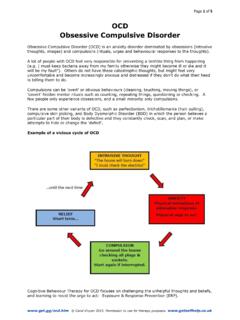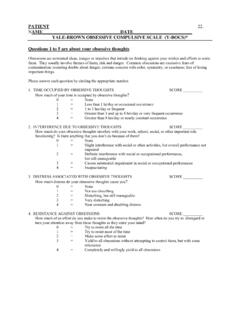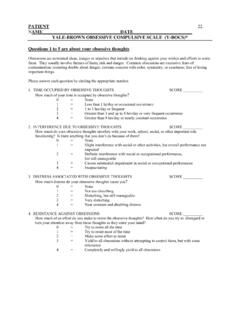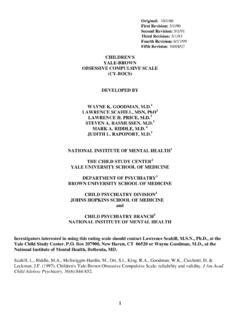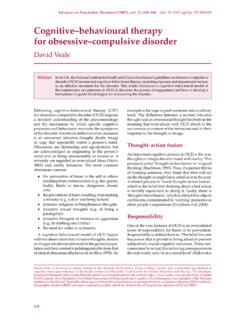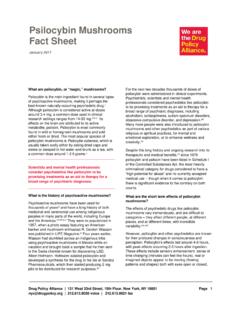Transcription of YALE-BROWN OBSESSIVE COMPULSIVE SCALE (Y-BOCS)
1 FIRST EDITION 7/86 (Revised 9/89) YALE-BROWN OBSESSIVE COMPULSIVE SCALE (Y-BOCS) DEVELOPED BY WAYNE K. GOODMAN, * STEVEN A. RASMUSSEN, LAWRENCE H. PRICE, *DEPARTMENT OF PSYCHIATRY MT. SINAI SCHOOL OF MEDICINE DEPARTMENT OF PSYCHIATRY BROWN UNIVERSITY SCHOOL OF MEDICINE Investigators interested in using this rating SCALE should contact Dr. Goodman at Mt. Sinai School of Medicine 1986 INTRODUCTION TO THE 9/89 REVISION This revised version of the Y-BOCS is not substantially different from the first version (7/86). We decided to follow the sage advice of our colleagues, "if it ain't broke, don't fix it". To preserve the psychometric properties demonstrated in studies of the original version (Goodman WK, Price LH, Rasmussen SA, et al, 1989a; 1989b), the principal probes and anchor points of the core Y-BOCS items (1-10) have not been modified. However, the specific frequency criteria have been deleted from items 1 and 6 in the interest of emphasizing the time criteria, which seem more reliable.
2 In some instances, there are minor wording changes. The instructions to item 4 (resistance to obsessions) have been expanded to clarify the assessment of patients who practice certain behavioral therapy techniques. No items have been omitted, but two new investigational items have been added to this version. Items 1b (obsession-free interval) and 6b (compulsion-free interval) are intended to examine a dimension of symptom severity (duration of symptom-free interval) which in some cases may complement items 1 and 6 (duration of symptoms). During the course of clinical improvement some patients with OCD seem to report lengthening of their symptom-free interval before they report shortening of the total hours occupied by their OBSESSIVE - COMPULSIVE symptoms. Future studies should reveal whether inclusion of items 1b and 6b enhances the sensitivity of the Y-BOCS to change. At present, these items are not included in the total Y-BOCS score.
3 A number of individuals have provided us with invaluable feedback on the Y-BOCS. We offer special thanks to Drs. Michael Jenike, John Griest, Katherine Shear, Richard Katz, Michael Kozak, and Eugene Gould. We also wish to acknowledge the fine work of the clinical, research, and secretarial staff of the Clinical Neuroscience Research Unit. Special thanks to Sally Trufan for her graphics work and to Elizabeth Kyle for typing the manuscript. YALE-BROWN OBSESSIVE COMPULSIVE SCALE (Y-BOCS) General Instructions This rating SCALE is designed to rate the severity and type of symptoms in patients with OBSESSIVE COMPULSIVE disorder (OCD). In general, the items depend on the patient's report; however, the final rating is based on the clinical judgement of the interviewer. Rate the characteristics of each item during the prior week up until and including the time of the interview. Scores should reflect the average (mean) occurrence of each item for the entire week.
4 This rating SCALE is intended for use as a semi-structured interview. The interviewer should assess the items in the listed order and use the questions provided. However, the interviewer is free to ask additional questions for purposes of clarification. If the patient volunteers information at any time during the interview, that information will be considered. Ratings should be based primarily on reports and observations gained during the interview. If you judge that the information being provided is grossly inaccurate, then the reliability of the patient is in doubt and should be noted accordingly at the end of the interview (item 19). Additional information supplied by others ( , spouse or parent) may be included in a determination of the ratings only if it is judged that (1) such information is essential to adequately assessing symptom severityand (2) consistent week-to-week reporting can be ensured by having the same informant(s) present for each rating session.
5 Before proceeding with the questions, define "obsessions" and "compulsions" for the patient as follows: "OBSESSIONS are unwelcome and distressing ideas, thoughts, images or impulses that repeatedly enter your mind. They may seem to occur against your will. They may be repugnant to you, you may recognize them as senseless, and they may not fit your personality." "COMPULSIONS, on the other hand, are behaviors or acts that you feel driven to perform although you may recognize them as senseless or excessive. At times, you may try to resist doing them but this may prove difficult. You may experience anxiety that does not diminish until the behavior is completed." "Let me give you some examples of obsessions and compulsions." "An example of an obsession is: the recurrent thought or impulse to do serious physical harm to your children even though you never would." "An example of a compulsion is: the need to repeatedly check appliances, water faucets, and the lock on the front door before you can leave the house.
6 While most compulsions are observable behaviors, some are unobservable mental acts, such as silent checking or having to recite nonsense phrases to yourself each time you have a bad thought." "Do you have any questions about what these words mean?" [If not, proceed.] On repeated testing it is not always necessary to re-read these definitions and examples as long as it can be established that the patient understands them. It may be sufficient to remind the patient that obsessions are the thoughts or concerns and compulsions are the things you feel driven to do, including covert mental acts. Have the patient enumerate current obsessions and compulsions in order to generate a list of target symptoms. Use the Y-BOCS Symptom Checklist as an aid for identifying current symptoms. It is also useful to identify and be aware of past symptoms since they may re-appear during subsequent ratings. Once the current types of obsessions and compulsions are identified, organize and list them on the Target Symptoms form according to clinically convenient distinctions ( , divide target compulsions into checking and washing).
7 Describe salient features of the symptoms so that they can be more easily tracked ( , in addition to listing checking, specify what the patient checks for). Be sure to indicate which are the most prominent symptoms; , those that will be the major focus of assessment. Note, however, that the final score for each item should reflect a composite rating of all of the patient's obsessions or compulsions. The rater must ascertain whether reported behaviors are bona fide symptoms of OCD and not symptoms of another disorder, such as Simple Phobia or a Paraphilia. The differential diagnosis between certain complex motor tics and certain compulsions ( , involving touching) may be difficult or impossible. In such cases, it is particularly important to provide explicit descriptions of the target symptoms and to be consistent in subsequent ratings. Separate assessment of tic severity with a tic rating instrument may be necessary in such cases.
8 Some of the items listed on the Y-BOCS Symptom Checklist, such as trichotillomania, are currently classified in DSM-III-R as symptoms of an Impulse Control Disorder. It should be noted that the suitability of the Y-BOCS for use in disorders other than DSM-III-R-defined OCD has yet to be established. However, when using the Y-BOCS to rate severity of symptoms not strictly classified under OCD ( , trichotillomania) in a patient who otherwise meets criteria for OCD, it has been our practice to administer the Y-BOCS twice: once for conventional OBSESSIVE - COMPULSIVE symptoms, and a second time for putative OCD-related phenomena. In this fashion separate Y-BOCS scores are generated for severity of OCD and severity of other symptoms in which the relationship to OCD is still unsettled. On repeated testing, review and, if necessary, revise target obsessions prior to rating item 1. Do likewise for compulsions prior to rating item 6.
9 All 19 items are rated, but only items 1-10 (excluding items 1b and 6b) are used to determine the total score. The total Y-BOCS score is the sum of items 1-10 (excluding 1b and 6b), whereas the obsession and compulsion subtotals are the sums of items 1-5 (excluding 1b) and 6-10 (excluding 6b), respectively. Because at the time of this writing (9/89) there are limited data regarding the psychometric properties of items 1b, 6b, and 11-16, these items should be considered investigational. Until adequate studies of the reliability, validity, and sensitivity to change of these items are conducted, we must caution against placing much weight on results derived from these item scores. These important caveats aside, we believe that items 1b (obsession-free interval), 6b (compulsion-free interval), and 12 (avoidance) may provide information that has bearing on the severity of OBSESSIVE - COMPULSIVE symptoms. Item 11 (insight) may also furnish useful clinical information.
10 We are least secure about the usefulness of items 13-16. Items 17 (global severity) and 18 (global improvement) have been adapted from the Clinical Global Impression SCALE (Guy W, 1976) to provide measures of overall functional impairment associated with, but not restricted to, the presence of OBSESSIVE - COMPULSIVE symptoms. Disability produced by secondary depressive symptoms would also be considered when rating these items. Item 19, which estimates the reliability of the information reported by the patient, may assist in the interpretation of scores on other Y-BOCS items in some cases of OCD. Name Date Y-BOCS SYMPTOM CHECKLIST (9/89) Check all that apply, but clearly mark the principal symptoms with a "P". (Rater must ascertain whether reported behaviors are bona fide symptoms of OCD, and not symptoms of another disorder such as Simple Phobia or Hypochondriasis. Items marked "*" may or may not be OCD phenomena.)
